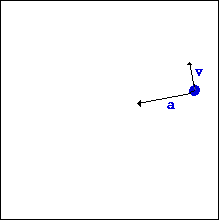
Uniform Circular
Motion
A GIF Animation
Uniform circular motion can be described as the motion of an
object in a circle at a constant speed. As an object moves in a
circle, it is constantly changing its direction. At all instances,
the object is moving tangent to the circle. Since the direction of
the velocity vector is the same as the direction of the object's
motion, the velocity vector is directed tangent to  the
circle as well. The animation at the right depicts this by means of a
vector arrow.
the
circle as well. The animation at the right depicts this by means of a
vector arrow.
An object moving in a circle is accelerating. Accelerating
objects are objects which are changing their velocity - either the
speed (i.e., magnitude of the velocity vector) or the direction. An
object undergoing uniform circular motion is moving with constant
speed; nonetheless, it is accelerating due to its change in
direction. The direction of the acceleration is inwards. The
animation at the right depicts this by means of a vector arrow.
The final motion characteristic for an object undergoing uniform
circular motion is the net force. The net force acting upon such an
object is directed towards the center of the circle; it is said to be
an inward or centripetal force. Without such an inward force,
an object would continue in a straight line, never deviating its
direction. Yet, with the inward net force directed perpendicular to
the veclocity vector, the object is always changing its direction and
undergoing an inward acceleration.
For more information on physical descriptions of motion,
visit
The
Physics Classroom. Specific information on circular motion will
be available soon at The Physics Classroom. Currently, specific
information is available about the following topics:
This page was created by
Tom
Henderson of
Glenbrook South
High School.
Comments and suggestions can be sent by e-mail to
Tom
Henderson.
This page last updated on 6/6/97.
 the
circle as well. The animation at the right depicts this by means of a
vector arrow.
the
circle as well. The animation at the right depicts this by means of a
vector arrow.